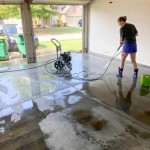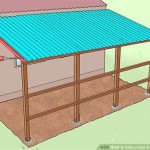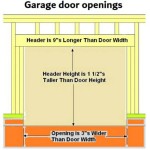How To Finish A Concrete Garage Floor
A well-finished concrete garage floor offers numerous benefits, including increased durability, resistance to stains and chemicals, improved aesthetics, and easier cleaning. This article provides a comprehensive guide to achieving a professional-looking and long-lasting finish for your concrete garage floor.
Preparing the Concrete Surface
Proper surface preparation is crucial for successful adhesion of any coating or sealant. The concrete must be clean, sound, and free of any contaminants that could interfere with the bonding process. This typically involves several steps:
Cleaning: Begin by thoroughly cleaning the floor to remove dirt, dust, grease, oil, and any existing coatings. A degreaser or concrete cleaner, along with a stiff-bristled brush, are effective for this purpose. A pressure washer can expedite the process, ensuring deep cleaning of the pores in the concrete. For stubborn stains, a specialized concrete cleaner or even a mild acid etch may be necessary.
Repairing: Inspect the floor for any cracks, chips, or spalling. Minor imperfections can be repaired using a concrete patching compound, following the manufacturer's instructions. Larger cracks or structural damage may require professional repair. Allow sufficient drying time for any repairs before proceeding to the next step.
Profiling: This step creates a slightly roughened surface, improving the bonding of the chosen finish. Methods include acid etching, grinding, or shot blasting. Acid etching is suitable for lightly textured surfaces, while grinding or shot blasting are preferred for smoother or denser concrete. After profiling, rinse the floor thoroughly to remove any residue and allow it to dry completely.
Choosing the Right Finish
Several finishing options are available for concrete garage floors, each with its own advantages and disadvantages. Consider the desired aesthetics, durability requirements, and budget when selecting the appropriate finish.
Epoxy Coatings: Epoxy provides a durable, high-gloss finish that is resistant to chemicals, stains, and abrasion. It is available in a wide range of colors and can be customized with decorative flakes or chips. Epoxy coatings require careful preparation and application, and they may be more expensive than other options.
Polyurethane Coatings: Polyurethane offers excellent resistance to chemicals, abrasion, and UV exposure. It is more flexible than epoxy, making it suitable for areas prone to minor movement or cracking. Polyurethane coatings are typically more moisture-resistant than epoxy, which is beneficial for garages in humid climates.
Concrete Sealers: Sealers penetrate the concrete surface, providing protection against stains, moisture, and de-icing salts. They are available in various sheens, from matte to glossy. Sealers are a more cost-effective option than coatings but offer less durability and chemical resistance. They are a good choice for garages where aesthetics are less critical than basic protection.
Concrete Paint: Concrete paint is an affordable option for enhancing the appearance of a garage floor. Specialized concrete paints offer improved adhesion and durability compared to standard paints. However, they are less resistant to chemicals and abrasion than epoxy or polyurethane coatings.
Applying the Finish
The application process varies depending on the chosen finish. Always follow the manufacturer's instructions carefully for best results.
General Application Guidelines for Coatings: Ensure adequate ventilation during application. Mix the coating components according to the manufacturer’s instructions. Apply the coating using a roller, brush, or sprayer, working in manageable sections. Maintain a wet edge to avoid lap marks. Allow the coating to dry and cure completely before using the garage.
General Application Guidelines for Sealers: Apply the sealer using a roller, brush, or sprayer, ensuring even coverage. Avoid puddles or excessive build-up. Allow the sealer to dry and cure fully before exposing the floor to traffic or moisture.
Multiple Coats: Multiple coats may be required for optimal performance and appearance, especially with coatings. Allow each coat to dry and cure completely before applying the next coat. Refer to the product instructions for recommended drying and curing times.
Properly finishing a concrete garage floor enhances its durability, appearance, and functionality. By carefully preparing the surface, choosing the right finish, and following the application instructions, you can achieve a professional-looking and long-lasting result that will provide years of service.

The Best Garage Floor Finishes Paint Tile More

The Facts About Polished Concrete Garage Floors All

The Facts About Polished Concrete Garage Floors All

The 3 P S Of Coatings For Concrete Floors

The 3 P S Of Coatings For Concrete Floors

How To Concrete Floors With Flakes Full Diy Tutorial

Garage Floor And Concrete Paint Rust Oleum

The Benefits Of Acrylic Garage Floor Sealers All Floors

How To Paint A Garage Floor Clean And Scentsible
5 Options For Covering Garage Floors
Related Posts








